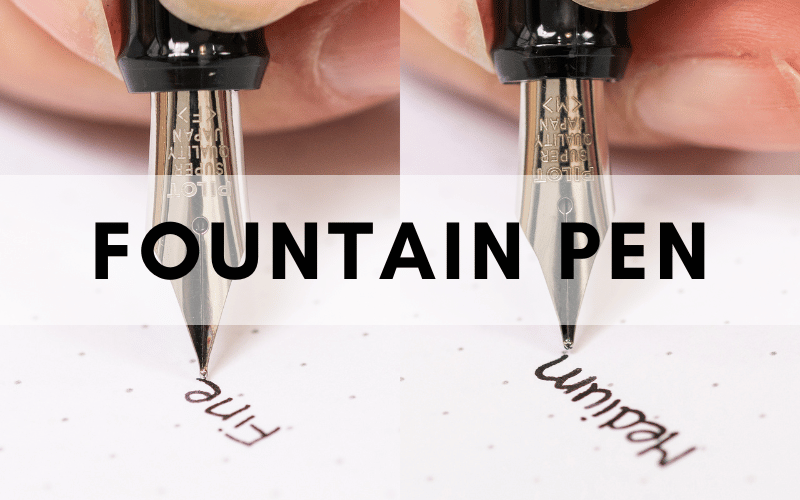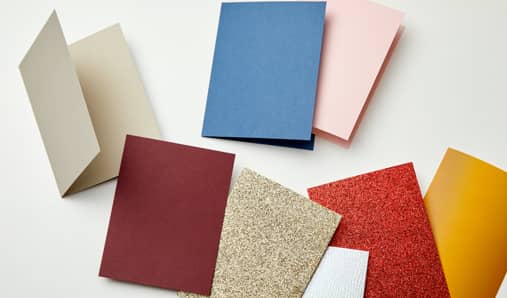In the age of digital screens and keyboards, the fountain pen retains its elegance. It glides across paper with ease, leaving a trail of ink that bears the mark of individuality, precision, and style. We invite you to explore the diverse and enchanting realm of fountain pens on this journey through the world of these writing instruments.
This article is your comprehensive guide to the types of fountain pens that have graced the desks and pockets of aficionados around the world, from their intriguing history to their intricate designs, from the materials that define their character to the myriad ways they cater to different writing needs.
History of Fountain Pens
The reed pen, which evolved into the fountain pen, was invented first by the ancient Egyptians. These early writing instruments, made of papyrus, had a split nib that allowed for a controlled flow of ink. In the fifth century, the Romans, never one to shy away from new ideas, introduced the quill pen made of feathers. This was a significant advancement in the evolution of writing instruments.
Quills provided a more consistent ink flow than reed pens, paving the way for future improvements. Fast forward to the Renaissance era, which saw a revival of interest in art, science, and exploration. During this period, the fountain pen as we know it began to take shape. Inventors such as Petrache Poenaru and Daniel Schwenter contributed significantly to the concept of a self-contained ink supply, a pivotal innovation.
Further refinements occurred in the 17th century when German inventor Daniel Schwenter’s design for a pen with an ink reservoir was realized. These “feather quill” pens provided a more consistent and extended writing experience. They were, however, far from perfect, frequently leaking and necessitating frequent maintenance.
The true watershed moment in fountain pen history occurred in the late nineteenth century when an American named Lewis Waterman patented the first dependable fountain pen. Waterman’s design included a capillary feed system that controlled ink flow, eliminating leakage and inconsistent writing. This breakthrough paved the way for fountain pen mass production and commercialization.
The early twentieth century was the golden age of fountain pens, with iconic designs and filling mechanisms introduced by companies such as Parker, Sheaffer, and Montblanc. Fountain pens became status symbols, adorning the desks of writers, diplomats, and professionals worldwide. The mid-twentieth century saw the introduction of the ballpoint pen, which was easier to maintain and provided a cleaner writing experience. Fountain pens experienced a period of decline, but their enduring popularity among collectors ensured their survival.
Fountain pens are still popular today, valued for their craftsmanship, individuality, and the unparalleled writing experience they provide. As we travel back in time, we discover the amazing inventions and innovations that transformed the humble reed pen into the sophisticated writing instrument we know and love today. The fountain pen is a testament to human ingenuity, an elegant tool that spans generations and leaves an indelible mark on history and the written word.
Anatomy of a Fountain Pen
A fountain pen is a finely crafted instrument with several intricate components that work together to provide a one-of-a-kind writing experience. Let us take a look at the basic components of a fountain pen and see how they work together to create the signature fountain pen writing sensation.
Nib: The nib is the heart and soul of a fountain pen, and it is typically made of stainless steel, gold, or iridium. It has a pointed tip with a split through which ink can flow. The line width and writing style are determined by the size and shape of the nib. Fine nibs result in thin lines, whereas broad nibs result in thicker strokes.
Feed: The feed is a small component beneath the nib that is often black, plastic, or ebonite (hard rubber). It is equipped with a series of thin fins or channels that control the flow of ink. The feed ensures that the nib receives a consistent supply of ink, preventing flooding or skipping while writing.
Barrel: The barrel is the pen’s main body, which is typically cylindrical in shape, though designs can vary greatly. It is where the ink reservoir is kept. Some barrels are made of precious materials such as resin, celluloid, or even metal, which adds to the pen’s visual appeal.
Ink Reservoir: The fountain pen‘s ink supply is stored in the ink reservoir, also known as the ink chamber or converter. There are various filling mechanisms that determine how ink is loaded into the reservoir, such as cartridge/converter systems, pistons, and eyedroppers.
Capillary action occurs when the cap is removed and the nib comes into contact with the paper. Ink can be drawn down to the paper through the slit in the nib and the channels in the feed. The point of the nib, which has a slight curvature, makes contact with the paper’s surface. As you write, capillary action draws ink from the feed and onto the paper. The flexibility of the nib, which is determined by its material and design, allows for variations in line width and shading as you write with different levels of pressure.
Types of Fountain Pen Nibs
Fountain pens have various kinds of nib options, each of which has its own characteristics and different writing styles and appearances. Let us take a look at the world of nibs, from fine to flex, and see how they affect the writing experience and visual aesthetics.
Fine Nib: A fine nib produces thin, delicate lines that are ideal for precise writing, taking notes, and doing detailed work. A fine nib provides smooth and consistent writing, making it an excellent choice for those who value precision and control.
Medium Nib: The medium nib strikes a balance between fine and broad, resulting in lines that are thicker than fine but not overly bold. It provides a versatile writing experience that is suitable for general use, such as daily writing, correspondence, and creative endeavors.
Broad Nib: A broad nib produces bold and expressive lines, giving your writing character and flair. It is favored by those who prefer a more pronounced, calligraphic appearance in their script.
Italic Nib: Italic nibs have a flat and wide tip with crisp edges. You will get a sharp contrast between thick downstrokes and thin upstrokes, which is ideal for calligraphy and artistic writing.
Flex Nib: A flex nib is an engineering marvel that responds to pressure and creates variations in line width. More pressure on the downstroke produces thicker lines, while lighter pressure produces thinner lines. Flex nibs are therefore popular for calligraphy, vintage-style writing, and expressive signatures.
Fountain Pen Filling Mechanisms
Fountain pens are not just about nibs and barrels; their filling mechanisms play a crucial role in determining how you load ink into your pen. Here, we’ll explore three common ink-filling mechanisms: cartridge/converter, piston, and eyedropper, and delve into their advantages and disadvantages.
Cartridge/Converter:
Advantages: Cartridges are pre-filled with ink. It makes them simple to replace when they run out. It also comes in a variety of colors and brands, allowing for quick ink changes.
Disadvantages: Cartridges typically contain less ink than other filling mechanisms, necessitating more frequent refills. Limited to cartridge-only inks; may not work with specialty or boutique inks.
Piston Filling Mechanism:
Advantages: Piston-filled pens have large ink reservoirs that allow for longer writing sessions. Compatible with a wider variety of inks, including specialty and shimmering inks. Piston pens can save money over time by eliminating the need for disposable cartridges.
Disadvantages: Piston fillers typically have more moving parts and necessitate meticulous maintenance. It may take some practice to master the piston-filling mechanism.
Eyedropper Filling Mechanism:
Advantages: Eyedropper-filled pens have the most ink capacity, making them ideal for marathon writing sessions.
Disadvantages: Changes in temperature or pressure can cause eyedropper pens to unexpectedly expel ink (burp). Because of their larger ink capacity, eyedropper pens, like cartridges, may not be suitable for specialty inks.
Materials and Designs
Plastic and resin pens come in a variety of colors, patterns, and finishes, making them accessible to all. These materials are strong and durable, ensuring that your pen will last a long time. These pens are frequently inexpensive and ideal for those just starting out with fountain pens.
Metal pens exude sophistication and durability and are available in stainless steel, aluminum, and brass. Metal pens have a substantial weight, which contributes to their premium feel and balance. Many metal pens have intricate engravings that add a touch of artistry to your writing tool.
Fountain pens made of precious metals such as gold, silver, or platinum are the epitome of luxury and prestige. These pens are often heirloom-worthy, designed to be cherished for generations. Hand-crafted patterns, gemstone accents, and meticulous craftsmanship can be found in precious metal pens.
Wooden pens have a warm and organic appearance, with each piece displaying unique grain patterns. Long writing sessions are made more enjoyable by the comfort of wooden barrels. For those who value green materials, there are sustainable and eco-conscious options available.
Acrylic pens sparkle with a rainbow of colors and can be polished to a brilliant shine. Some acrylic pens are translucent, allowing you to see the ink reservoir within. Limited-edition acrylic pens can quickly become collector’s items.
Retro designs are vintage-inspired, with ornate clips and classic materials evoking the elegance of bygone eras.
Modern Minimalism: Modern pens are sleek and streamlined, emphasizing clean lines and simplicity.
Artisanal pens are known for their meticulous craftsmanship, with hand-turned bodies and one-of-a-kind finishes.
Specialized Fountain Pens
Calligraphy Pens: These pens have italic or flex nibs and are ideal for artistic writing. Pilot Parallel and Manuscript CalliCreative are two well-known brands.
Sketching Pens: For precise lines and inking, artists prefer fountain pens with fine or extra-fine nibs, such as the LAMY Safari or Platinum Carbon Desk Pen.
Everyday Writers: Pens like the LAMY 2000 and Pilot Metropolitan provide the ideal balance of comfort and performance for everyday use.
Iconic Fountain Pen Brands:
Several illustrious manufacturers grace the world of fountain pens, each with their own distinct signature styles and innovations.
Montblanc: Known for its Meisterstück line, this iconic brand embodies luxury and sophistication. Montblanc is famous for its meticulous craftsmanship and use of precious materials.
Parker: Parker is well-known for his Duofold and Sonnet collections. Their pens often feature timeless designs and innovations like the Parker 51’s hooded nib.
LAMY: Modern minimalism defines LAMY’s design ethos, with pens like the LAMY 2000 and Safari garnering global acclaim for their Bauhaus-inspired simplicity.
Aurora: The Aurora 88, known for its piston filler and classic design, exemplifies the company’s commitment to quality and innovation.
Sailor: Sailor stands out for its meticulous nib craftsmanship. The Sailor 1911 series is well-known for its flawless writing performance.
Each of these manufacturers adds to the rich tapestry of fountain pen history by offering a variety of styles and innovations that cater to the tastes and preferences of fountain pen enthusiasts all over the world.
Fountain Pens in the Digital Age
The fountain pen endures as an embodiment of craftsmanship and individuality in our digital age, where screens and keyboards predominate. Its elegant paper script transcends the digital realm, providing a tactile, personal connection to the written word.
Fountain pens are more than just writing instruments; they are expressions of one’s identity, with each stroke a testament to the art of writing. In an age of fleeting digital messages, the permanence of ink on paper reminds us that craftsmanship and individuality are still important, anchoring us to a world in which the written word is a work of art.
Conclusion
We uncovered a diverse world of materials, nibs, and designs of a fountain pen that fills up every writing need and preference. From plastic to precious metals, fine to flex nibs, these pens are more than just writing instruments; they are personal expressions of identity and craftsmanship. In the era of digital technology, the fountain pen stands as a symbol of the enduring art of writing.
We encourage you to embark on your own fountain pen journey. Explore the vast array of options available and discover the pen that resonates with your style and preferences.







